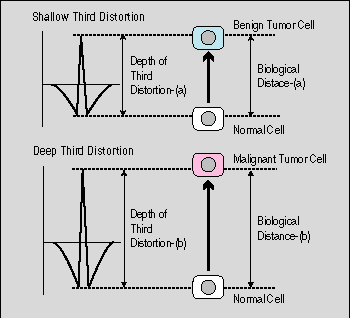 |
 |
|
|
|
 |
VI. Carcinogenesis 2/2
Consider theoretically what is different between benign and malignant tumor. |
|
|
|
|
|
|
|
4. How does tissue distortion divide tumorigenesis between benign and malignant one?
Next, consider theoretically how the depth of tissue distortion divides a tumor between a benign and a malignant tumor. Theoretically, It is concluded as follows. When a tissue causes shallow tissue distortion, it transforms normal cells into benign tumor cells which belong to a level in normal cells. In contrast, when a tissue causes deep tissue distortion, it transforms normal cells into cancer cells which differ in level from normal cells. In short, compared with tissue distortion at benign tumorigenesis, that at carcinogenesis is deep, so that it can transform the containing cells into cancer cells. The figure below illustrates the difference in tissue distortion between a benign and a malignant tumor. |
|
|
|

|
|
(Whereas shallow tissue distortion transforms the containing cells into benign tumor cells, deep one transforms the containing cells into malignant cells.) |
|
|
|
More theoretically speaking, the depth of third distortion can be considered to play a role in dividing a tumor between a benign and a malignant tumor. My cancer theory concludes that there are three kinds of tissue distortions: initial, secondary, and third distortion. Of these three tissue distortions, third distortion has the ability to carry the containing cells to a new level, and to transform the cells into tumor cells Thus, whereas shallow third distortion transforms the containing cells into new normal cells: benign tumor cells, deep one carries over the level of normal cells and transforms the containing cells into new cells quite different from normal cells, and which are cancer cells.
(If you are interested in the difference among these three types of tissue distortions: initial, secondary, and third one, please check my "Distorted-Field Theory." This theory explains in details the different points among these three types of tissue distortions.) |
|
|
|
5. Depth of Third Distortion and Biological Distance
Using a theoretical concept of "Biological Distance" allows us to explain the depth of third distortion. As explained above, third distortion carries the containing cells from the original cellular level to a new cellular level. In this mechanism, the distance from the original cellular level to a new cellular level just indicates the biological distance from the original cell to a new cell.
For example, shallow third distortion carries the containing cells from the original cellular level to a level that is a little separate from the original cellular level; deep one carries the containing cells from the original cellular level to a level that is quite separate from the original cellular level. Thus, if we use the concept of "Biological Distance," we can say that whereas shallow third distortion carries the containing cells for short biological distance, deep one carries the containing cells for long biological distance. The figures below illustrate these mechanisms. |
|
|
|

|
|
(As shown in the figures above, shallow third distortion has the ability to move the containing cells for short biological distance; deep one has the ability to move the containing cells for long biological distance. ) |
|
|
|
6. Summary
As seen in the explanation in this section, the outbreak process of carcinogenesis is basically the same as that of benign tumorigenesis. Although cancer appears to differ completely from a benign tumor, it resembles a benign tumor in outbreak mechanism. The most important theoretical different point between a benign and a malignant tumor originates in the depth of third distortion. |
|
|
|
|
|
|
MyBook

PDF File Download

(Donation Ware)
SugiInternalMedicineClinic
MIKIOSUGI: 杉幹雄
Present Japan Time:
2025/12/07 (Sun) 16:07:51 |
|